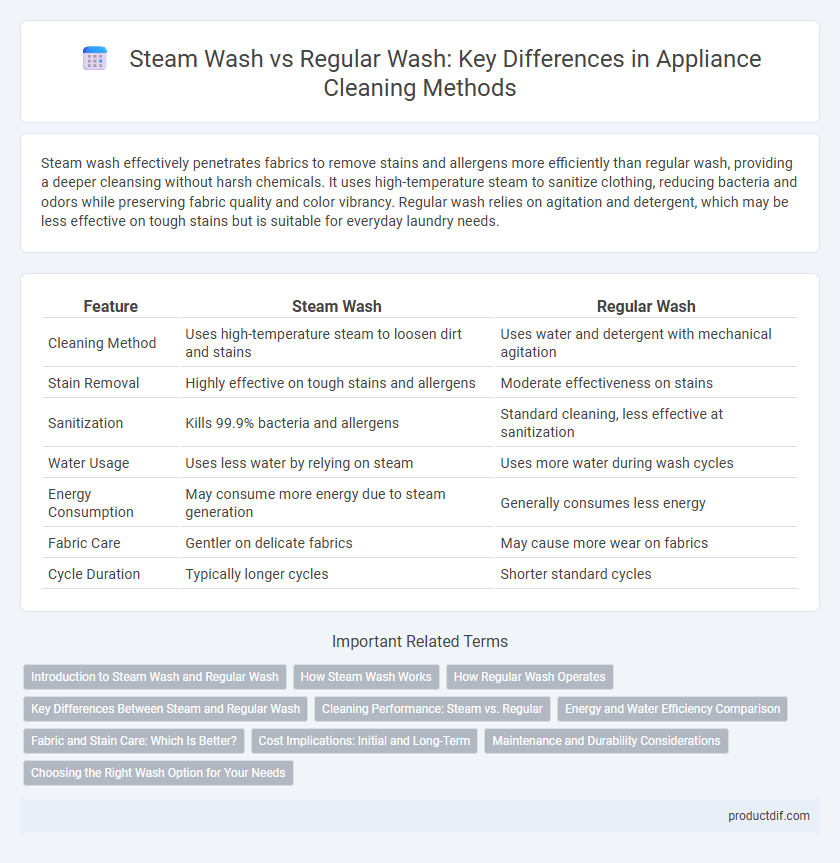Steam wash effectively penetrates fabrics to remove stains and allergens more efficiently than regular wash, providing a deeper cleansing without harsh chemicals. It uses high-temperature steam to sanitize clothing, reducing bacteria and odors while preserving fabric quality and color vibrancy. Regular wash relies on agitation and detergent, which may be less effective on tough stains but is suitable for everyday laundry needs.
Table of Comparison
| Feature | Steam Wash | Regular Wash |
|---|---|---|
| Cleaning Method | Uses high-temperature steam to loosen dirt and stains | Uses water and detergent with mechanical agitation |
| Stain Removal | Highly effective on tough stains and allergens | Moderate effectiveness on stains |
| Sanitization | Kills 99.9% bacteria and allergens | Standard cleaning, less effective at sanitization |
| Water Usage | Uses less water by relying on steam | Uses more water during wash cycles |
| Energy Consumption | May consume more energy due to steam generation | Generally consumes less energy |
| Fabric Care | Gentler on delicate fabrics | May cause more wear on fabrics |
| Cycle Duration | Typically longer cycles | Shorter standard cycles |
Introduction to Steam Wash and Regular Wash
Steam wash utilizes high-temperature steam to penetrate fabrics, effectively removing dirt and stains while sanitizing clothes without harsh chemicals. Regular wash relies on water, detergent, and mechanical action to clean garments, which may be less effective on tough stains and allergens. Steam washing enhances fabric care by reducing wrinkles and odors, making it ideal for delicate or heavily soiled items.
How Steam Wash Works
Steam wash uses high-temperature steam to penetrate fabrics, effectively loosening dirt, grease, and tough stains without harsh agitation. This method sanitizes clothes by killing bacteria and allergens, ensuring a deeper clean compared to traditional water-only cycles. The steam also helps reduce wrinkles and fabric wear, extending the life of garments while saving water and energy.
How Regular Wash Operates
Regular wash cycles use mechanical agitation and detergent to remove dirt and stains from clothes, relying on water temperature and spin speed to enhance cleaning efficiency. This method systematically loosens and lifts soil through continuous drum rotation, typically at higher RPMs to extract water during the final spin. Energy consumption and water usage vary depending on load size and cycle selection but generally remain lower than specialized wash types like steam wash.
Key Differences Between Steam and Regular Wash
Steam wash uses high-temperature steam to penetrate fabrics, eliminating bacteria and heavy stains more effectively than regular wash cycles that rely on water and detergent alone. Steam cycles often reduce the need for harsh chemicals and can be gentler on delicate fabrics, extending the lifespan of garments compared to standard wash methods. Regular wash cycles typically run faster and use less energy, but may not provide the deep cleansing and sanitizing benefits offered by steam technology.
Cleaning Performance: Steam vs. Regular
Steam wash technology utilizes high-temperature steam to penetrate fabrics, effectively removing tough stains and killing bacteria, resulting in superior cleaning performance compared to regular wash cycles. Regular wash relies on detergent and mechanical agitation, which may struggle with deeply embedded dirt and allergens. Studies show steam washes can eliminate up to 99.9% of bacteria, enhancing hygiene and fabric care beyond traditional methods.
Energy and Water Efficiency Comparison
Steam wash technology significantly reduces water consumption by using high-temperature steam to penetrate and loosen dirt, leading to less rinsing required compared to regular wash cycles. Energy efficiency improves as steam cycles often operate at lower temperatures for shorter durations, minimizing electricity usage while maintaining cleaning performance. In contrast, regular wash cycles typically demand more water and longer heating times, resulting in higher energy and water consumption.
Fabric and Stain Care: Which Is Better?
Steam wash offers superior fabric care by gently loosening dirt and stains without harsh agitation, reducing wear and tear on delicate materials. Regular wash cycles rely on mechanical action and higher water temperatures, which can fade colors and weaken fibers over time. For stain removal, steam effectively penetrates fibers to lift tough stains while preserving fabric integrity, making it a better choice for both fabric preservation and stain care.
Cost Implications: Initial and Long-Term
Steam wash appliances typically have a higher initial purchase price compared to regular wash machines due to advanced technology and built-in steam generators. Over the long term, steam wash cycles use less water and detergent, leading to cost savings on utility bills and laundry supplies. The durability and reduced wear on clothes with steam wash also contribute to lower garment replacement expenses, offsetting the initial investment.
Maintenance and Durability Considerations
Steam wash machines require less frequent deep cleaning due to their high-temperature sanitization, which helps break down detergent residues and reduces mold buildup, enhancing maintenance ease. Regular wash cycles may necessitate more routine maintenance to prevent odor and residue accumulation, potentially affecting the appliance's longevity. The durability of steam wash appliances often benefits from advanced components designed to withstand higher thermal stress, contributing to prolonged operational life.
Choosing the Right Wash Option for Your Needs
Steam wash uses high-temperature steam to penetrate fabrics, effectively removing tough stains and allergens while being gentle on delicate materials. Regular wash relies on water and detergent agitation to clean clothes, suitable for everyday laundry with less intensive soil. Choosing the right wash option depends on fabric type, stain severity, and sensitivity to allergens, with steam wash ideal for deep cleaning and regular wash for routine maintenance.
Steam wash vs Regular wash Infographic

 productdif.com
productdif.com